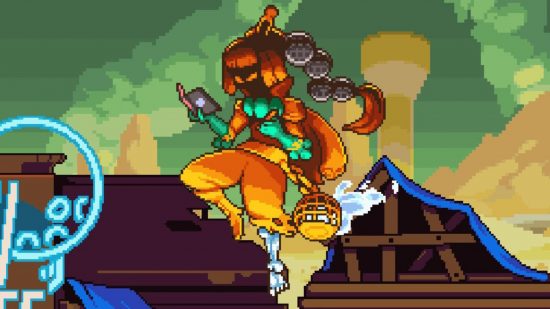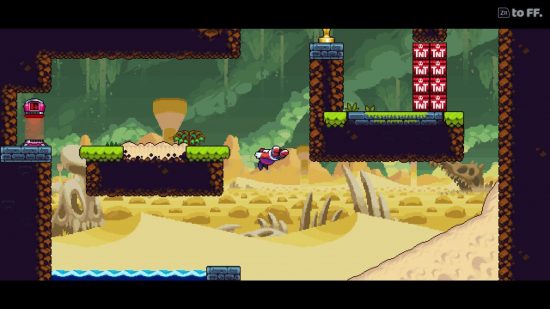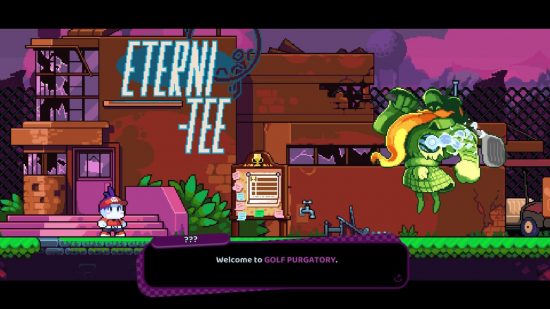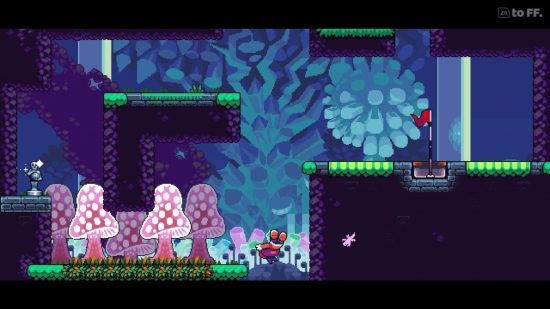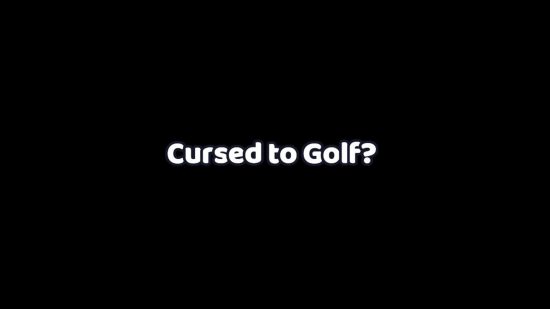Our Verdict
Cursed to Golf balances harsh roguelike elements with playful and endearing level design and game mechanics. This, combined with the gorgeous art and excellent tunes make for a beautifully well-rounded package that’s hard to put down.
Every time I try to describe Cursed to Golf I want to use the word ‘little’. This isn’t derisive, I just feel like calling it a brilliant little game whenever I think about writing about it. I think it’s because of the wonderfully simple, miniature set of things it tries to do, which create something so playful and endearing.
The core idea is golf. You hit the button to choose your power, you hit it again to choose the trajectory. This is every golf game. It’s a core idea that just works. The difference here is everything around it. It has a 2D map like a side-scroller, various cards that can have wacky effects, and a slowly depleting ball count that acts like your health.
So, how did it end up like this? Well, our protagonist is a superstar golfer, on course to win the next big championship. Just as they swing for the hole a bolt of lightning strikes them and they die. This is great for two reasons: one, it acts as a tutorial for the most basic mechanics, and two, it sets up the conceit.
Our golfer has fallen into golf purgatory, where a giant green man called The Scotsman meets and greets you before explaining all the strangenesses that occur down in this strange place. There are traps beyond just bunkers and water, teleportation devices, and ball-destroying spikes, all paving a gauntlet that does not want you to win.
To get over these challenges you need to get good at golf. Beyond the basic power and aim options, there’s also a spin mechanic. This gives the ball a life of its own, letting you spin it in a certain direction far beyond anything realistic. You can also apply spin as the ball lands, and then fine-tune exactly where you want it to land.
This feels great due to the controller input required to pull it off. You mash the face button and push the stick in the direction you want, making it feel like turning a heavy truck or something. You’re fighting with the ball to give you every last inch of its fantasy momentum, just to pull off some alien trick shot or get through a tiny crevice. It’s excellent.
There are also playing cards that behave as power-ups to make your life easier. There are basic ones, like additional shots and practice shots, alongside some excellently inventive ones. What if the ball was a rocket? What if you had portals? What if the ball could freeze water? I love it when you can hear the questions that led to this sort of inventiveness, and I sure can here.
All of these aspects are fit into a roguelike structure. There are eighteen holes to get through on one run, four bosses that don’t reappear after defeating them, and a general pervading thought that completing a full run is completely impossible. This game is tough, and the less persistent may find that frustrating.
One thing that kinda ameliorates this issue is the comeback mechanic, which allows you to place a flag after a completed hole and return there if you die. This is cool but didn’t always seem to work. If you use the ‘quick tee off’ option you just restart a new run. Maybe I’m using it wrong, but I’m not completely sure how it works.
There’s also a fast-forward button which you can use to zip through the game, and this is one of my favourite features. I don’t play enough golf games to know if this is common or not, but fast-forward buttons need to be in everything. It’s so nice.
All this lovely stuff wouldn’t be so great if it didn’t look, feel, and sound so amazing. The gorgeous pixel art from Jon Davies is so full of character and charm, with different boss animations purveying their personality effortlessly. I love the silly look on our golfer’s face, the peace sign their ghost makes when they complete a hole and the consistent quality of art and animation throughout.
Then the music from Mark Sparling utilises squidgy synths to match up to all that beauty. There are excellent tunes here, plucking different melodies to fit different bosses or locales. It fits perfectly, even if this game does suit sound-off, handheld sessions in front of the tele.
It’s all these elements that help Cursed to Golf feel like a brilliantly well-rounded package. Wherever you look, it feels like care and attention combined with a true love of messing around have shaped every corner of the game. As you move through a level and utilise different contraptions, it all makes sense, and it all makes me smile. It’s just great fun.
Sadly, this review was delayed due to a software crash after the first boss, and there are apparently some other bugs that the devs fixed recently. This is a shame, of course, but Chuhai Labs has been consistently communicating through their social channels and jumped to fix any issues very quickly, so hopefully no others crop up.
In spite of the bugs, this game never fails to be enjoyable. Best of all, the fun isn’t negated by any extraneous parts – the small team that made this implemented exactly what they needed to. In a tidbit that didn’t make it into my recent Cursed to Golf interview with creator Liam Edwards, he said that fun is all it comes down to at the end of the day, and you can really feel it when you play.
And while some aspects can occasionally drag, and the harshness of the roguelike structure won’t be to everyone’s taste, this brilliant little game always succeeds in making me have a good time. Big and crunchy music, slick and charming pixel art, and brilliantly constructed gameplay… what more could you want?
